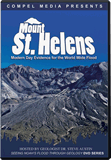
Did Greenhouse Gases Help Create Dinosaurs?
Global greenhouse gases: paving the way for dinosaurs or documenting the upheavals of the global Flood?
News Source
- Science: “Did Greenhouse Gases Unleash the Dinosaurs?”
Mass extinctions are apparent in the fossil record wherever some sort of organism virtually disappears from the geologic column above a certain layer. One of the most well-known mass extinctions is the disappearance of the dinosaurs and a number of other organisms at the K-T (Cretaceous-Tertiary) boundary. Paleontologists continue to debate the “Yucatan asteroid” versus worldwide volcanism explanations for the K-T event. But what about other mass extinction events? What caused them? Greenhouse gases may offer some answers.
The “end-Triassic extinction,” dated by secular paleontologists at 201 million years ago, “wiped out half the known species on land and in the sea.” Evolutionists believe the elimination of competition from creatures like “the early relatives of the crocodiles” paved the way for the successful Jurassic evolution of dinosaurs. What they would like to know is what killed off those other species.
Geochronologists have dated rock formed by “massive outpourings of lava now strewn along the edges of the North Atlantic Ocean” and decided they coincide with the onset of the end-Triassic extinction. Therefore, assuming the volcanism had something to do with the extinction event, researchers have been searching for clues as to how volcanism and extinction are connected.
Now paleontologist Micha Ruhl of Utrecht University believes he’s found the answer. Ruhl has analyzed carbon isotope ratios in plant wax molecules from layers of marine sediment. The carbon isotope ratios shift dramatically at the end of the Triassic period. The change strongly suggests there was a massive outpouring of methane into the environment. The carbon from that methane would have eventually found its way into plants living at the time, leaving the isotope ratio preserved there.
The most obvious source of methane would be massive volcanism. But even with this “volcanic-greenhouse gas-extinction” connection, paleontologists continue to wonder just how this ancient global warming killed off so many species.
Let’s sort out the facts and the assumptions. First of all, knowing the assumptions underlying the radiometric dating of the rock layers cannot be proven, we can discount the 201-million-year date for the extinction. But regardless of the date, some sort of mass extinction event is documented above the Triassic layer in the geologic column.
The Flood geology model explains most of these mass extinctions as a result of massive upheavals during the global Flood. Large numbers of creatures were rapidly buried as their ability to flee the rising waters was overwhelmed. Thus the geologic column represents not a series of extinctions over evolutionary time but closely spaced mass extinctions and burials due to global Flood and local, early post-Flood catastrophes.
But what about Ruhl’s discovery that methane, probably from a volcanic source, was poured into the environment? In the original paper, the authors note the presence of additional toxic gases such as sulfur dioxide and comment, “Concurrent vegetation changes reflect strong warming and an enhanced hydrological cycle.”1 They specify that the “changes and extinctions directly coincide with the onset of this warming event” and suggest that the “massive carbon release” acidified the ocean, “leading to reduced marine ecosystem stability and extinctions.”2
Actually, the results of this research and the authors’ interpretation fit the Flood geology model quite nicely. At the beginning of the Flood and continuing for at least 150 days, massive volcanic activity occurred. Genesis 7:11 records that the “fountains of the great deep were broken up.
” Methane released into the atmosphere would have ultimately been incorporated into the plants until they died. Those isotope ratios are actually evidence for the global Flood. The global Flood could certainly be characterized as a time of ecosystem instability resulting in deaths on a massive scale! Once again, what we see in God’s world is consistent with what we read in God’s Word.
Further Reading
- Radiometric Dating: Back to Basics
- Radiometric Dating: Problems with the Assumptions
- Radiometric Dating: Making Sense of the Patterns
- Salt Lake Extinction
For More Information: Get Answers
Remember, if you see a news story that might merit some attention, let us know about it! (Note: if the story originates from the Associated Press, FOX News, MSNBC, the New York Times, or another major national media outlet, we will most likely have already heard about it.) And thanks to all of our readers who have submitted great news tips to us. If you didn’t catch all the latest News to Know, why not take a look to see what you’ve missed?
(Please note that links will take you directly to the source. Answers in Genesis is not responsible for content on the websites to which we refer. For more information, please see our Privacy Policy.)
Footnotes
- Micha Ruhl et al., “Atmospheric Carbon Injection Linked to End-Triassic Mass Extinction,” Science 333, no. 6041 (July 22, 2011): 430–434, doi:10.1126/science.1204255.
- Ibid.
Recommended Resources

Answers in Genesis is an apologetics ministry, dedicated to helping Christians defend their faith and proclaim the good news of Jesus Christ.
- Customer Service 800.778.3390
- © 2024 Answers in Genesis





